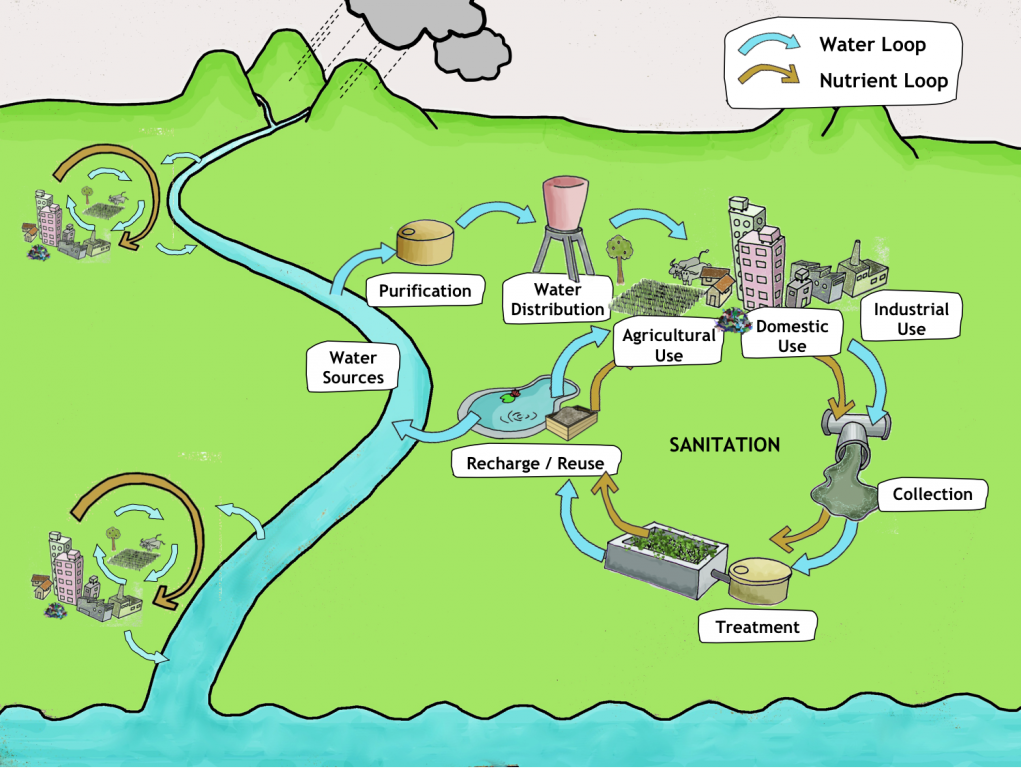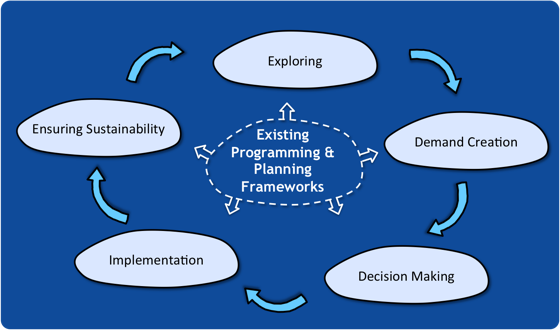Difference between revisions of "SSWM Toolbox"
(Published from sandbox) |
|||
| Line 27: | Line 27: | ||
===Implementation Tools=== | ===Implementation Tools=== | ||
| − | |||
This section contains both technical (Hardware) as well as economic, political and social instruments (Software). | This section contains both technical (Hardware) as well as economic, political and social instruments (Software). | ||
Revision as of 22:11, 27 May 2014
Introducing the Sustainable Sanitation and Water Management Toolbox, an integrative tool for capacity development on the local level.
The Sustainable Sanitation and Water Management Toolbox recognizes that sectoral approaches are not going to solve the global water and sanitation crisis. It highlights that we need holistic approaches and must consider the entire water cycle from source to sea, and back, and puts human influence on the water and nutrient cycle at the centre.
But what are such holistic approaches? What is understood by Integrated Water Resources Management? And what does Sustainable Sanitation actually mean? And how do we link the two, and bring in agriculture into the play?
Contents
Linking up Sustainable Sanitation, Water Management and Agriculture

Water management, sanitation and agriculture are inherently linked: When we use water, for agriculture, in our homes, in industry etc, we contaminate water with different substances. Yet, what we commonly call “contaminants” can be a valuable resource in other places - e.g. as nutrients in agriculture. In that way, wastewater is not a waste, but a resource that has been misplaced. We've create a factsheet that argues that sectoral thinking and current approaches to wastewater management are the root of many other problems, amongst them a lack of water and nutrients in agriculture, insufficient yields, and health problems and environmental contamination. Only an approach that recognises wastewater as a resource can overcome these problems.
Read more on this Factsheet.
Understand Your System

This part of the Sustainable Sanitation and Water Management Toolbox is designed as a tutorial to help you in getting an overview of your area in terms of water and sanitation and to help you identify the most pressing problems. It allows you to find specific problems, while keeping in mind the whole picture, i.e., the whole water and nutrient cycle, including its relations to sanitation and agriculture.
This section should allow you to get an overview of your local water and nutrient cycle. It will help you to identify root causes, and how problems are linked, thus giving you and a deeper understanding of the interrelationships between the water resources management, sanitation and agriculture in your specific locality.
Read more about this section, Understand your system.
Planning & Process Tools

Based on the classic project cycle, many organisations developed step-by-step participatory programming and planning frameworks or approaches to help you to find, select, implement and ensure the long-term sustainability of sanitation, water and hygiene interventions. What all frameworks and approaches have in common, is that they all follow the idea that all the involved and affected people and groups should be involved in the whole process. This, not only by informing them, but by actively including the stakeholders in the planning, decision making, implementation and follow up process to ensure the long-term sustainability of projects and programmes. Though there is no consensus on the number of “steps” or how they should be named, most approaches cover at least the five steps as in the blue graph (to the right).
Read more details about this Planning process.
Implementation Tools
This section contains both technical (Hardware) as well as economic, political and social instruments (Software).
Seven overarching themes include a large number of different tools to:
- Water Sources Management
- Water Purification
- Water Distribution
- Water and Nutrient Use
- Wastewater Collection
- Wastewater Treatment
- Reuse and Recharge of Nutrients and Water
These themes represent an ideal water and sanitation management system. It puts humans and their influence on the water and nutrients at the centre, yet proposes a loop-based system, which is sustainable and durable.
Your local water and sanitation system might look a bit different and some parts might be even missing in your case. Yet, the different software and hardware tools will give you an idea on what kind of solutions have been successfully implemented in various parts of the world to make local sanitation and water management systems more sustainable, to reduce the use of water or to efficiently recycle the generated wastewater and nutrients. Not all tools will work in your specific case and you will have to assess which ones could be the most promising in your case. The Understand your System section will help you to identify problems, root causes and interdependencies. Complete this exercise first, before choosing solutions!
Read more about these Implementation tools.
Tutorial Video & Manual
- This 11 minute video shows you how best to use the SSWM toolbox:
- Here is an offline version of this toolbox: Offline SSWM Toolbox
Acknowledgements
- The information on this page (plus more within the links) are from a larger SUSTAINABLE SANITATION AND WATER MANAGEMENT TOOLBOX, by SSWM.
